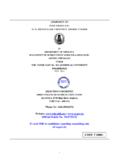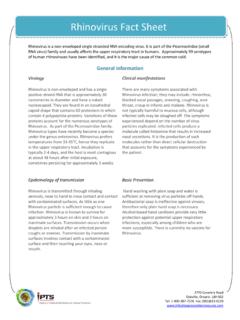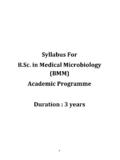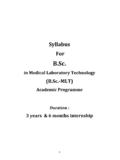Transcription of WHO EXPERT CONSULTATION ON RABIES
1 1 WHO Technical Report Series 931 WHO EXPERT CONSULTATION ON RABIES First Report 2 WHO Library Cataloguing-in-Publication Data WHO EXPERT CONSULTATION on RABIES (2004 : Geneva, Switzerland) WHO EXPERT CONSULTATION on RABIES : first report. (WHO technical report series ; 931) - prevention and control vaccines virus surveillance ISBN 92 4 120931 3 (NLM classification: WC 550) ISSN 0512-3054 World Health Organization 2005 All rights reserved. Publications of the World Health Organization can be obtained from WHO Press, World Health Organization, 20 Avenue Appia, 1211 Geneva 27, Switzerland (tel: +41 22 791 2476; fax: +41 22 791 4857; email: Requests for permission to reproduce or translate WHO publications whether for sale or for noncommercial distribution should be addressed to WHO Press, at the above address (fax: +41 22 791 4806; email: The designations employed and the presentation of the material in this publication do not imply the expression of any opinion whatsoever on the part of the World Health Organization concerning the legal status of any country, territory, city or area or of its authorities, or concerning the delimitation of its frontiers or boundaries.))
2 Dotted lines on maps represent approximate border lines for which there may not yet be full agreement. The mention of specific companies or of certain manufacturers products does not imply that they are endorsed or recommended by the World Health Organization in preference to others of a similar nature that are not mentioned. Errors and omissions excepted, the names of proprietary products are distinguished by initial capital letters. All reasonable precautions have been taken by the World Health Organization to verify the information contained in this publication. However, the published material is being distributed without warranty of any kind, either express or implied. The responsibility for the interpretation and use of the material lies with the reader. In no event shall the World Health Organization be liable for damages arising from its use. This publication contains the collective views of an international group of experts and does not necessarily represent the decisions or the stated policy of the World Health Organization.
3 This publication contains information on certain vaccines that international experts appointed by WHO have found to be safe and efficacious when applied by the intradermal route for RABIES pre- and post-exposure prophylaxis. The evaluation of safety and efficacy is based on the assessment of a review of published articles (in peer-reviewed journals) on clinical studies (on safety, immunogenicity and efficacy) conducted with these products and an analysis of laboratory tests results carried out as part of these studies by independent laboratories or for the control of these products by national control authorities and/or by the manufacturers. Therefore, inclusion in this publication does not constitute a warranty of the suitability of any individual batch of vaccine for a particular purpose. The responsibility for the quality, safety and efficacy of each individual batch of vaccines remains with the manufacturer.
4 3 Furthermore, WHO does not warrant that: 1. the vaccines that have been found to be safe and efficacious by the intradermal route will continue to be so; 2. the vaccines have obtained regulatory approval for post-exposure prophylaxis of RABIES (or any other disease) in every country of the world, or that their use is otherwise in accordance with the national laws and regulations of any country, including but not limited to patents laws. In addition, WHO wishes to alert procuring United Nations agencies that the improper storage, handling and transportation of vaccines may affect their quality, efficacy and safety. WHO disclaims any and all liability and responsibility for any injury, death, loss, damage or other prejudice of any kind whatsoever that may arise as a result of or in connection with the procurement, distribution and use of any vaccine or other product mentioned in this publication.
5 The information in this publication should not be used for promotional purposes. Typeset in Printed in 4 Contents 1. Introduction Methods to estimate the burden of RABIES Estimated burden of RABIES in the world 2. Classification of lyssaviruses Distinguishing features of lyssaviruses Demarcation criteria in the Lyssavirus genus 3. Pathogenesis and diagnosis Pathogenesis Diagnosis Clinical diagnosis in humans Laboratory diagnosis Techniques for postmortem diagnosis of RABIES in animals and humans Techniques for intra vitam diagnosis of RABIES in humans Virus identification using molecular techniques: epidemiological considerations 4. Management of RABIES patients before and after death Treatment of RABIES patients Transmission via organ transplants Recommendations for safe clinical management of RABIES patients Postmortem management of bodies of patients that have died of RABIES 5.
6 RABIES vaccines and immunoglobulins RABIES vaccines for humans Human vaccine types Potency requirements for human vaccines Failure of vaccines and full post-exposure prophylaxis Routes of administration Vaccines for animals Animal vaccine types Potency requirements for animal vaccines Safety of animal vaccines RABIES immunoglobulins 6. Prevention of RABIES in humans Pre-exposure vaccination Post-exposure prophylaxis General considerations Certificate of post-exposure prophylaxis Complications of post-exposure prophylaxis 7. National programmes for the control of RABIES in dogs Epidemiological surveillance Canine mass parenteral vaccination campaigns Supplementary measures: oral vaccination of dogs 5 Dog population management and animal birth control (ABC) programmes National and international cooperation 8. Control of RABIES in wild animals Epidemiology and ecology of RABIES in carnivore species Africa Asia Europe North America South America Caribbean islands Eurasian and American Arctic and subarctic regions RABIES in bats Lyssaviruses in Africa, Australia and Eurasia RABIES in insectivorous bats in the Americas Vampire bats RABIES RABIES in rodents Wildlife species of special concern Elimination of RABIES in wild Carnivora Reduction of animal population Wildlife immunization Planning, implementation and evaluation of oral vaccination programmes Bat RABIES control Other public health measures 9.
7 RABIES -free and provisionally RABIES -free countries or areas 10. International transfer of animals International transport of companion animals from RABIES -infected countries or areas to RABIES -free countries or areas International transport of companion animals between RABIES -free countries or areas Special exemption for guide dogs for people with disabilities, and other service dogs International transport of livestock, zoo, research and show animals from RABIES -infected countries or areas to RABIES -free countries or areas International transport of any animal from RABIES -free to RABIES -infected countries or areas or between RABIES -infected countries or areas 11. Exchange of information Collection of epidemiological data Regional activities for RABIES information exchange Africa Asia Americas Europe Mediterranean Seminars, group training and fellowships 612.
8 Research considerations for the 21st century Basic research Diagnostics Molecular, genetic and epidemiological characterizations of new isolates Biologicals Treatment Epidemiology Pathobiology Operational research for canine RABIES control RABIES : a priority in national health policy Coordinated national RABIES programme Supportive laws and regulations Infrastructure and capacity Availability of adequate quantities of modern immunizing agents for pre- and post-exposure treatment Dog population management and mass immunization Community awareness Advocacy for RABIES prevention and control at national level Acknowledgments References Annex 1 Guide for post-exposure prophylaxis Annex 2 Suggested RABIES vaccination certificate for humans Annex 3 Addresses of international institutions for technical cooperation in RABIES control Annex 4 International RABIES certificate for dogs, cats and ferrets Annex 5 Suggested case-record form for human exposure to RABIES Annex 6 Rabnet, an interactive and information mapping system for human and animal RABIES 7 WHO EXPERT CONSULTATION on RABIES Geneva.
9 5 8 October 2004 Participants Dr D. Briggs, Adjunct Professor, Department of Diagnostic Medicine/Pathobiology, College of Veterinary Medicine, Kansas State University, Manhattan, KS, USA Dr H. Bourhy, Head, RABIES Unit, Department of Ecosystems and Epidemiology of Infectious Diseases, Pasteur Institute and Director, WHO Collaborating Centre for Reference and Research on RABIES , Paris, France Dr S. Cleaveland, Senior Lecturer, Tropical Animal Health, Centre for Tropical Veterinary Medicine, University of Edinburgh, Easter Bush Veterinary Centre, Roslin, Midlothian, Scotland Dr F. Cliquet, Director, Research Laboratory for RABIES and Pathology of Wild Animals and Director, WHO Collaborating Centre for Research and Management on Zoonoses Control, National Centre on Veterinary and Food Studies (AFSSA), Malz ville, France Dr H. Ertl, Professor and Programme Leader, Immunology Programme, The Wistar Institute and Director, WHO Collaborating Centre for Reference and Research on RABIES , Philadelphia, PA, USA Dr A.
10 Fayaz, Head, Virology Department, Pasteur Institute of Iran and Director, WHO Collaborating Centre for Reference and Research on RABIES , Tehran, Islamic Republic of Iran Dr A. Fooks, Head, Veterinary Laboratories Agency, Department of Virology and Director, WHO Collaborating Centre for the Characterization of RABIES and RABIES -related Viruses, Addlestone, Weybridge, England Dr T. Hemachudha, Professor of Medicine and Neurology, Chulalongkorn University Hospital, Bangkok, Thailand Dr R. L. Ichhpujani, Deputy Director General, Directorate General of Health Services, Ministry of Health and Family Welfare, New Delhi, India Dr W. R. Kaboyo, Assistant Commissioner for Veterinary Public Health and Zoonoses Control, Ministry of Health, Kampala, Uganda (Rapporteur) Dr H. Koprowski, Professor, Department of Immunology and Microbiology, Thomas Jefferson University and Director, WHO Collaborating Centre for Neurovirology, Philadelphia, PA, USA Dr S.

















